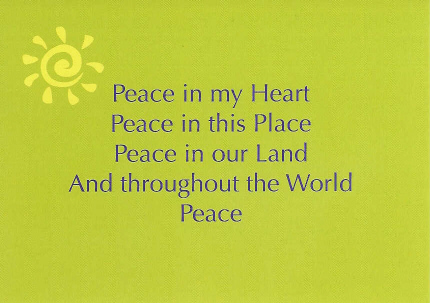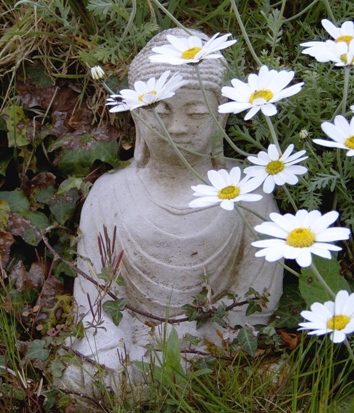Peace in my Heart
Peace in this Place
Peace in our Land
And throughout the World
Peace
(The Peace Mantra)

Carmen from the Netherlands writes: 'I started my day with the peace mantra today and I intend to do so every day from now on. I'm so happy I found out about the foundation, because saying the mantra makes me feel like I can contribute to a positive vibe in this world of turmoil. If lots and lots of people join in, it is bound to do at least some good.'
![]() Please scroll down to find the following items:
Please scroll down to find the following items:
The central role of the Peace Mantra
Free Peace Mantra postcards
What does the Peace Mantra mean to you?
Some ways of using the Peace Mantra
A few tips
Adapting the Peace Mantra
Peace 'inside-out' quotations
The significance of the Foundation's logo
 The central role of the Peace Mantra
The central role of the Peace Mantra
At the heart of the Peace Mantra Movement lies the Peace Mantra. It reflects our belief that the cultivation of peace starts within the individual person, before rippling out into the community, nation, and the entire world. The more people who do this, the greater the ripple effect will be.
The Peace Mantra continues to speak deeply to many people. Some find it helps them find or maintain inner peace during difficult times such as stress, uncertainty, or bereavement. Others find it brings a sense of comfortable balance at various times during the day or night. Perhaps this is due to the simplicity, clarity and rhythm of the words, as well as the intention behind them.
The Peace Mantra is explored in more depth on the next four pages: Peace in my Heart, Peace in this Place, Peace in our Land, and Peace in our World. These pages include our suggestions as to what practical steps we can take to help bring about peace.

 Free Peace Mantra postcards
Free Peace Mantra postcards
We have created four attractively designed Peace Mantra postcards. These are free (although donations in £ sterling are always welcome) and can be ordered by emailing Steve - see the Contact Us page.Some people keep a postcard on their bedside table, or else they display it on their fridge or noticeboard. Many people like to offer them to friends, family, or colleagues.

 What does the Peace Mantra mean to you?
What does the Peace Mantra mean to you?
Perhaps at this point you may like to pause for a few moments to focus upon the Peace Mantra.
How does it speak to you?
How can you use it in a meaningful way, rather than just repeating an empty succession of words?
Just as there are many paths leading to the top of the mountain, so there are many different ways in which the Peace Mantra can be used. This section outlines a few possibilities based upon my own and other people's experiences. I would like to stress that these suggestions are not intended in any way to be prescriptive; whatever works for you is of course right for you!
Please contact me (Steve)if you wish to discuss anything on this page, or if you would like to share your experiences.
 Some ways of using the Peace Mantra
Some ways of using the Peace Mantra
The Peace Mantracan be reflected upon:-first thing in the morning
last thing at night
any time during the day or night
The words can be spoken, chanted, sung or simply thought. To help focus upon the meaning of the words while repeating them, and to allow peace to root and radiate more fully:-
they can be repeated slowly
a period of silence can be left between each line (the length of silence can vary from a few seconds to many minutes)
each line can be repeated many times, with intervening silence
The mantra can be chanted in many different ways. These can include:-
chanting on any single note which feels comfortable (usually in the medium-low register)
chanting using a very simple melody and rhythm, of around four-five different notes in all. The melody and rhythm should be easy to remember, to enable a strong focus to be maintained upon the meaning of the words.
The mantra can be chanted as a whole, or one line can be taken and repeated. I find it helpful to chant continuously for at least 20 minutes; this can help the positive vibrations to build, resonate and radiate.
The mantra also lends itself to creative singing, which might take the form of a free improvisation, or a specific composition. When doing this I try always to focus upon the meaning of the words, and the intention behind them. This helps to guide the improvisation or composition.
The Peace Mantra may inspire other forms of creativity, such as painting, drawing, verse, prose, dance, etc.
 A few tips
A few tips
Many people find the following tips useful:- focus with a 'light' attitude, rather than being too serious, earnest or heavy. It may help to imagine that your eyes are bright, even when closed, and that your lips are close to breaking into a smile or laugh. Some images of the Buddha and of the resurrected Christ convey this feeling.
focus with a 'light' attitude, rather than being too serious, earnest or heavy. It may help to imagine that your eyes are bright, even when closed, and that your lips are close to breaking into a smile or laugh. Some images of the Buddha and of the resurrected Christ convey this feeling.
Be aware of why you are focusing upon the Peace Mantra. Are you doing it just for yourself, or for others, or for both?
Leave enough silence after speaking, chanting or singing the mantra to 'think' the words and their meaning.This will allow the peaceful vibrations to continue resonating inwards and outwards, rather than being dissipated prematurely by activity or mind chatter.
It is also good to remember that reflection upon the mantra goes hand-in-hand with everyday living. Remembering this will help to make the whole of our lives congruent. Vibrations of peace built up during our 'inner' times will carry on resonating during our relations with others.
 Adapting the Peace Mantra
Adapting the Peace Mantra
As its form is so simple the Peace Mantra can easily be adapted to focus upon other qualities. These are only some suggestions; you may of course wish to add others:-
Love - Forgiveness - Justice - Healing - Freedom - Patience
Spontaneity - Joy - Light -Laughter - Acceptance - Unity
Any of the above words can be substituted for 'Peace' in the mantra. For instance, if we focus upon Love (in its unconditional sense), the mantra would become:
Love in my Heart
Love in this Place
Love in our Land
And throughout the World
Love
While repeating these words, try to focus upon the cultivation of love within your heart, and imagine it radiating out into the community, nation and the entire world.
 Peace 'inside-out' quotations
Peace 'inside-out' quotations
The UK Peace Foundation's 'inside-out' approach to peace is nothing new. Many people down the ages have expressed a similar belief:-
If there is to be peace in the world,
There must be peace in the nations.
If there is to be peace in the nations,
There must be peace in the cities.
If there is to be peace in thecities,
There must be peace between neighbours.
If there is to be peace between neighbours,
There must be peace in the home.
If there is to be peace in the home,
There must be peace in the heart.
(Lao Tzu)
It is no longer good enough to cry peace, we must act peace, live peace, and live in peace.
(Shenandoah Proverb)
First keep the peace within yourself, then you can also bring peace to others.
(Thomas a Kempis)
We frail humans are at one time capable of the greatest good and, at the same time, capable of the greatest evil. Change will only come about when each of us takes up the daily struggle ourselves to be more forgiving, compassionate, loving, and above all joyful in the knowledge that, by some miracle of grace, we can change as those around us can change too.
(Mairead Maguire)
Peace is not merely a distant goal that we seek, but a means by which we arrive at that goal.
(Martin Luther King, Jr.)
Responsibility does not only lie with the leaders of our countries or with those who have been appointed or elected to do a particular job. It lies with each of us individually. Peace for example, starts within each one of us. When we have inner Peace, we can be at Peace with those around us.
(The Dalai Lama)
 The significance of the Foundation's logo
The significance of the Foundation's logo
Our logo has beencreated by Pharic. It reflects the twin aspects of the Mantra: the journey within (spiral) and the radiating outwards (like flower petals or sun-rays):-



